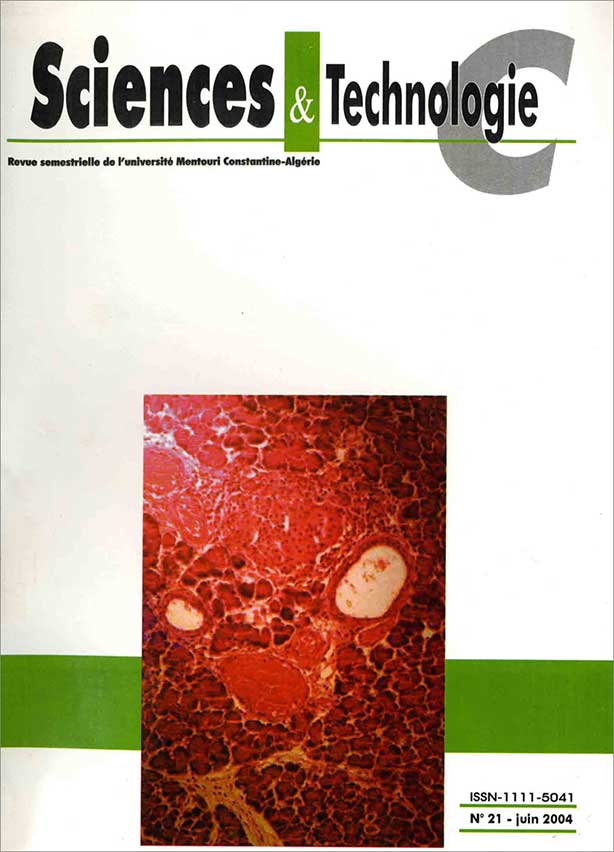CARACTERISATION PHENOTYPIQUE DE SOUCHES DE RHIZOBIA ISOLEES DE QUATRE ESPECES DE MEDICAGO DANS LA VALLEE DE LA SOUMMAM (ALGERIE)
Keywords:
rhizobia, Medicago, diversity, phenotypicAbstract
10 souches de rhizobia ont été isolées des nodules de 4 espèces Medicago (M. polymorpha, M. minima, M. arabica, M. orbicularis), récoltées dans 4 sites de la vallée de la Soummam (Béjaïa, Algérie). La caractérisation phénotypique a porté sur les aspects morphologiques, culturaux des colonies et physiologiques, par une série de tests. Le traitement numérique des résultats des tests physiologiques regroupe les souches en 4 clusters formés à un faible niveau de similarité, indiquant leur diversité phénotypiqueReferences
- Stackebrandt E., Murray R.G.E., Truper H.G., "Proteobacteria classis nov., a name for the phylogenetic taxon that includes the purples bacteria and relatives", Int. J. Syst. Bacteriol., 38 (1988), pp. 321-325.
- Jordan D.C., "Rhizobiaceae", In Bergey’s manual of systematic bacteriology, N.R. Krieg and J.C. Holt (ed.), The Williams and Wilkins Co., Baltimore, vol.1, (1984), pp.234-254.
- Colwell R.R., "Polyphasic taxonomy of the genus Vibrio : numerical taxonomy of Vibrio cholerae, Vibrio parachaemolyticus, and related Vibrio species", J. Bacteriol., 104 (1970), pp.410-433.
- Vandamme P., Pot B., Gillis M., De Vos P., Kesters K., Swings J., "Polyphasic taxonomy , a consensus approach to bacterial systematics", Microbiol. Rev., 60 (1996), pp.407-438.
- Allen O.N., Allen E.K.,"The Leguminosae : a source book of characteristics, uses and nodulation", University of Wisconsin Press, Madison, USA (1981), pp.21-25.
- Lesins K., Lesins I., "Genus Medicago (Leguminosae). A taxogenic study", Junk, The Hague, The Netherlands (1979).
- de Lajudie P., Willems A., Pot B., Dewetting D., Maestrojuan G., Neyra M., Collins M.D., Dreyfus B., Kesters K., Gillis K., "Polyphasic taxonomy of Rhizobia : Emendation of the genus Sinorhizobium and description of Sinorhizobium meliloti comb nov., Sinorhizobium saheli sp. nov., and Sinorhizobium teranga sp.nov. ", Int. J. Syst. Bacteriol., 44 (1994), pp.715-733.
- Rome S., Fernandez M.P., Brunel B., Normand P., Cleyet J-C.,"Sinorhizobium medicae sp. Nov., isolated from annual Medicago spp.", Int. J. Syst. Bacteriol., 46 (1996), pp.972-980.
- Van Berkum P., Beyene D., Bao G., Campbell T.A., Eardly B.D., "Rhizobium mongolense sp. nov. is one of three rhizobial genotypes identified which nodulate and form nitrogen-fixing symbiosis with Medicago ruthenica", Int. J. Syst. Bacteriol., 48 (1998), pp.13-22.
- Ai Min Yan, En Tao Wang, Feng Ling Kan, Zhi Yuan Tan, Xin Hua Sui, Barbara Reinhold-Hurek, Wen Xin Chen, "Sinorhizobium meliloti associated with Medicago sativa and Melilotus spp. in arid saline soils in Xinjiang, China", Int. J. Syst. Evol. Microbiol., 50 (2000), pp.1887-1891.
- Brunel B., Rome S., Ziani R., Cleyet J.C., "Comparison of nucleotide diversity and symbiotic properties of Sinorhizobium meliloti populations from annual species of Medicago", FEMS. Microbiol. Ecol., 19 (1996), pp.71-82.
- Vincent J.M., "The manual for the practical study of root nodule bacteria", Blackwell Scientific Publications Ltd., Oxford, United Kingdom (1970).
- Reinhold-Hurek B., Hurek T., "Life grasses : diazotrophic endophytes", Trends Microbiol., 6 (1998), pp.139-144.
- Zehrari K., "Diversité phénotypique et génotypique des rhizobia isolés de régions arides et sahariennes du Maroc nodulant quatre espèces d’Acacia : A. cyanophylla, A. gummifera, A. horrida et A. tortilis sub-espèce raddiana", Thèse de Doctorat es-sciences Biologie, Microbiologie, Université Mohammed V-AGDAL de Rabat, Maroc (2000).
- de Lajudie P., Willems A., Nick G., Molouba F., Hoste B., Torck B., Neyra M., Lindström K., Collins M.T., Dreyfus B. L., Gillis M. "Characterisation of tropical tree rhizobia and description of Mesorhizobium plurifarium sp. Nov.", Int. J. Syst. Bacteriol., 48 (1998a), pp.369-382.
- Aurag J., and Sasson A., "Tolerance of Rhizobium leguminosarum bv phaseoli to acidity and drought", W.J. Microbiol. Biotechno., 8 (1992), pp.532-533.
- Nour S.M., Fernandez M., Normand P., Cleyet-Marel J.C., "Rhizobium ciceri sp. nov., consisting of strains that nodulate chickpeas (Cicer arientinum . L)", Int. J. Syst. Bact., 44 (1994), pp.511-522.
- El Sheikh E.A.E., Wood M., "Response of chickpea and soybean Rhizobia to salt : osmotic and specific ion effects of salts", Soil Biol. Biochem., 217 (1989), pp.889-895.
- Lindström K., Lehtomäki S., "Metabolic properties, maximum growth temperature and phage sensitivity of Rhizobium sp. (Galega) compared with other fast-growing rhizobia", FEMS Microbiol Lett., 50 (1988), pp.277-287.
- Zhang, X., Harper R., Karsisto M., Lindstrom K., "Diversity of Rhizobium bacteria isolated from root nodules of leguminous trees", Int. J. Syst. Bacteriol., 41(1991), pp.104-113.
- Kassem M., Capellano A., Gounot A.M., "Effets du chlorure de sodium sur la croissance in vitro, l’infectivité et l’efficience de Rhizobium meliloti", MIRCEN Journal, 1 (1985), pp.63-75.
- Elkan G.H., "Taxonomy of rhizobia", Can. J. Microbiol., 38 (1992), pp.446-450.
- Sadowsky M.J., Keyser H.H., Ben Bohlool B., "Biochemical characterisation of fast and slow-growing rhizobia that nodulate soybeans", Int. J. Syst. Bacteriol., 32 (1983), pp.716-722.


